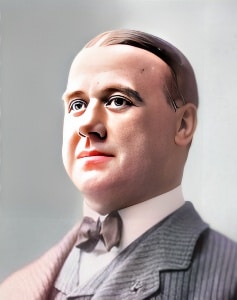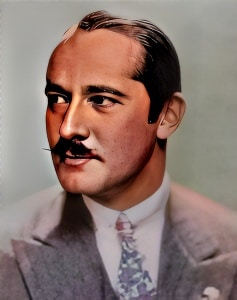 Lewis Montagna, renowned by his stage name Bull Montana, was a multifaceted Italian-American talent, making his mark as a professional wrestler, boxer, and actor.
Lewis Montagna, renowned by his stage name Bull Montana, was a multifaceted Italian-American talent, making his mark as a professional wrestler, boxer, and actor.
Born Luigi Montagna on May 16, 1887, his journey from the athletic arena to the silver screen is a captivating tale of discovery and versatility.
Montagna’s introduction to the world of cinema came in a rather serendipitous manner. In 1917, while in a New York gymnasium, his physical prowess caught the eye of none other than producer Douglas Fairbanks. Recognizing the potential of this imposing figure, Fairbanks enlisted him for the film “In Again, Out Again,” marking the inception of Bull Montana’s cinematic odyssey.
The pinnacle of Montagna’s early film career came in 1919 when he portrayed a macabre villain in Maurice Tourneur’s acclaimed masterpiece “ Victory,” sharing the screen with the legendary Lon Chaney. This collaboration marked a significant chapter in his cinematic journey and showcased his ability to bring depth to antagonist roles.
In 1921, Montagna’s commitment to his adopted homeland was solidified as he was granted US citizenship, prompting him to change his name to Lewis Montagna. From 1922 onward, he found himself at the forefront of a successful series of parodies produced by Hunt Stromberg, demonstrating his versatility as an actor with comedic flair.
However, it was in 1925 that Montagna achieved widespread recognition for his distinctive physicality and appearance. Cast as the ape-man in the film “The Lost World,” he captivated audiences with his commanding presence, solidifying his status as a memorable figure in cinema.
Montagna’s trajectory continued to ascend as he collaborated with iconic figures of the silent era. His partnership with Rodolfo Valentino in films such as “The Four Horsemen of the Apocalypse” and “The Son of the Sheik” showcased his adaptability, seamlessly transitioning between various genres and roles.
The late twenties and early thirties saw Bull Montana continue to thrive in the industry, often cast in antagonist roles reminiscent of fellow actor Louis Wolheim. His on-screen presence resonated with audiences, and he found himself alongside Buster Keaton in “Palooka from Paducah” and collaborating with Buster Crabbe in the 1936 series “Flash Gordon.”
Montagna’s cinematic journey, spanning from 1917 to 1937, saw his active participation in nearly 90 films. His legacy is etched not only in the sheer volume of his filmography but also in the diverse characters he brought to life. Bull Montana’s contribution to silent cinema extends beyond his imposing physicality, encompassing a range of roles that showcased his adaptability and enduring appeal.
As the curtain fell on his film career, Lewis Montagna left an indelible mark on the cinematic landscape. His legacy persists as a testament to the dynamic and transformative nature of early Hollywood, where a former wrestler and boxer could evolve into Bull Montana, an iconic figure of the silver screen.
Loading live eBay listings...




